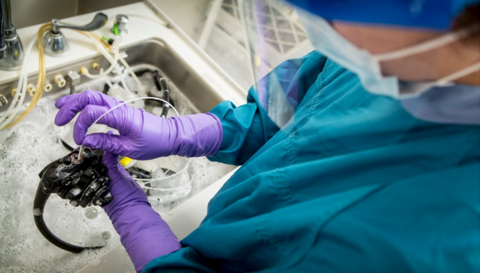
The Ruhof Corporation developed the first enzymatic detergent for cleaning medical instruments in 1976. Prior to this development, many practitioners struggled to properly clean endoscopes and other equipment.
Professional organizations such as the Centers for Disease Control and Prevention (CDC) and the American Society for Gastrointestinal Endoscopy (ASGE) and other professional organizations recommend using enzymatic cleaners for surgical instruments and endoscopes. The enzyme toolbox has expanded, and today enzymatic detergents demonstrate improved stability and functionality under a wide variety of conditions.
The enzymes in these detergents target and digest specific soils. For example, Ruhof's pioneering enzymatic detergents contain:
• Carbohydrases & Amylases - enzymes that catalyze carbohydrates into sugars
• Lipases - an enzyme that quickly "digests" lipids (fats)
• Proteases - an enzyme that breaks down proteins
Non-enzymatic detergents take longer to loosen and remove contaminants, and they may not clean hard-to-reach areas as thoroughly as enzymatic products.
Cleaning with enzymatic detergents removes organic soils such as blood, mucus, feces or tissue from instrument surfaces. If not removed, these soils can dry and adhere tightly to surfaces. This can create a microbe-packed biofilm that reduces the effectiveness of disinfectants and sterilants.
These contaminants are also corrosive and can pit instrument surfaces. Pits can harbor contaminants, making it harder to clean the instrument and even more vulnerable to biofilm development.
Ruhof's Endozime® Bio-Clean is a truly unique enzymatic detergent which has been designed to target Bioburden and Biofilm on semi-critical and critical medical devices. The product is the only enzymatic detergent on the market clinically tested to pass the difficult ISO 15883 Annex F*, doing so by dissolving the extracellular polymeric layer encasing the bacteria in Biofilm and exposing them to high-level disinfectants or liquid chemical sterilants.
The use of enzymatic products should start during the pre-cleaning process at the point of use immediately following procedures. Enzymatic foams, gels and humectants designed for pre-cleaning aid in loosening soils and keeping instruments moist pending further cleaning until reprocessing begins. This discourages soils from drying and forming biofilms.
After the instruments are transported to the sterile processing department or cleaning room, they undergo manual cleaning, which involves pre-soaking, cleaning and thorough rinsing. An enzymatic detergent should be used during the pre-soak and cleaning phase.
It’s critical to meticulously follow the manufacturer’s instructions for use (IFU). The effectiveness of enzymatic detergents depends on a number of factors, including proper concentration, contact time, water temperature and quality, e.g., pH, hardness, presence of chlorides and so on. Staff should also use the recommended brushes or sponges.
Detergents are also used in the mechanical cleaning phase in ultrasonic cleaners, automated washer/disinfectors and automatic endoscope reprocessors (AERs). There is a common misperception that enzymatic detergents should be the same brand as the automatic washer. Ruhof’s products are fully compatible with all mechanical washers.
Improperly cleaned surgical instruments and reusable devices such as endoscopes create a serious risk of healthcare-acquired infections not only for patients, but also for healthcare personnel. Thorough cleaning is the most important means of significantly lowering these risks.
Ruhof offers a range of enzymatic products for every stage of the cleaning process.
To request samples and/or contact a sales rep for more info, visit www.ruhof.com/pages/generous-samples-of-any-product
